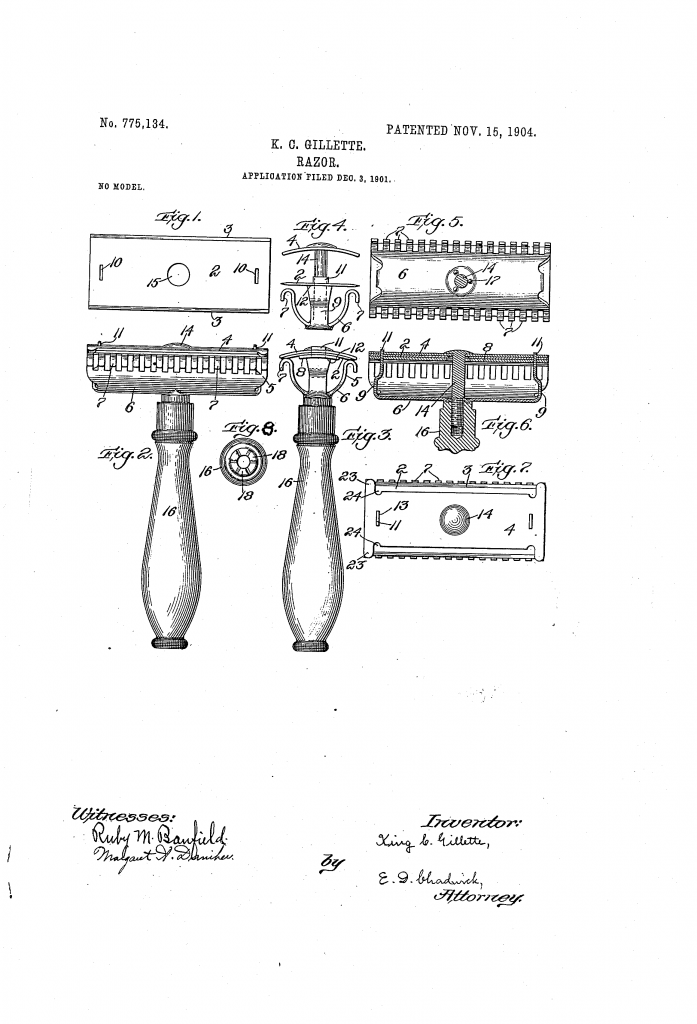A few days ago we had a look at a 1917 Gillette advertisement, which referenced a patent filed in 1901. And today we look at that patent – and how it differs from Gillette’s better known and slightly newer patent for the Old Type safety razor.
But before we get into the differences, let’s see what King wanted to achieve with his invention:
A main object of my invention is to provide a safety-razor in which the necessity of honing or stropping the blade is done away with, thus saving the annoyance and expense involved therein, and to this end I make the blade of my razor of very thin sheet-steel, thereby getting rid of a large amount of metal which has heretofore been required to give the blade the proper amount of strength and rigidity, and I secure this blade to a holder so constructed as to provide a rigid backing and support for the blade, as well as a handle therefor so that although my blade itself is readily flexible by reason of its thinness and lacks the rigidity of the ordinary razor-blade yet when it is combined with its holder it receives a degree of rigidity sufficient to make it practically operative.
From US Patent 775,134
So, in short, King wanted to create the modern safety razor using a thin, replaceable, and disposable blade. The blade would be too flexible to shave with all by itself. Instead it would get the necessary rigidity from the blade holder – what we today would think of as the razor proper.

There are two big differences between the patent we’re looking at today, and the patent for the Old. For starters, the bottom plate looks radically different. The Old Type razor have a bottom plate that is little more than a shaped piece of metal with three evenly spaced holes. King’s patent filed in 1901 has a more complex baseplate made from bent and curved sheet metal, with a sheet metal post protruding on either end.
More importantly however is the different shape of blade. King’s 1901 filing shows a blade with one hole and two slots – the centre hole lines up with a stud, and the two narrow slots lines up with the posts on the base plate. His later and better known patents have a three hole blade, where the two outer holes lines up with studs on the top cap as well as holes in the bottom plate.
This of course necessitates some differences in the top cap too. Instead of the two studs we know and… know from the Old Type, the 1901 filing has a top cap with two slots that mirrors the slots in the blades.
However – and this is important – there is no conceptual difference between the patent King filed in 1901 and the GIllette Old Type as it was eventually manufactured.
They both uses a thin, replaceable blade – instead of the wedge blades that were common in safety razors of the time.
They both uses three points of alignment for the blade. The Old Type have two round posts and a threaded stud on the top cap. The 1901 filing have two sheet metal posts on the base plate and a threaded bold mounted on the top cap. To drive the point home; the razor depicted in the 1901 filing would only require a slight resizing and repositioning of the upright posts to be able to use the three hole blade – or even a modern slotted blade.
Which is not to say that the 1901 filing is flawless. The best proof would be that it don’t depict the razor that was eventually manufactured. There are two things that stands out to me. First of, the blade would probably be a little harder to manufacture. Slots are more difficult to cut out of thin sheet metal than round holes.
Secondly, the razor head would likely be a little more fiddly to align for reassembly. On an old type, I just drop the blade onto the top cap, drop the base plate on, and then tighten the knob/handle. On the razor in the 1901 filing, I would have to mount the blade on the two posts, then guide the top plate onto it so the slots lined up, then mount and tighten the handle.
In short, the patent filed in 1901 was almost all the way there. But the Old Type as manufactured was a little bit more idiot-proof, as likely a little easier and cheaper to manufacture.
The full patent can be read on Google Patents as well as on Razors.click.

Pingback: Gillette's first patent filed in 1901 - Razors n Blades the shave that saves
Pingback: The Man and His Wonderful Shaving Device - Wegian WetshavingWegian Wetshaving
Pingback: No shadow of doubt... - Wegian WetshavingWegian Wetshaving